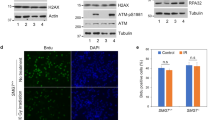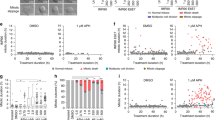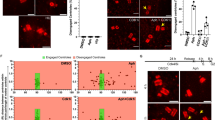Abstract
The long-term cellular response to DNA damage is controlled by the tumor suppressor p53. It results in cell-cycle arrest followed by DNA repair and, depending on the degree of damage inflicted, premature senescence or apoptotic cell death. Here we show that in normal diploid fibroblasts the ubiquitin ligase anaphase-promoting complex or cyclosome (APC/C)–Cdh1 becomes prematurely activated in G2 as part of the sustained long-term but not the rapid short-term response to genotoxic stress and results in the degradation of numerous APC/C substrates. Using HCT116 somatic knockout cells we show that mechanistically premature APC/C activation depends on p53 and its transcriptional target p21 that mediates the signal through downregulation of the APC/C inhibitor Emi1. Cdc14B is dispensable in this setting but might function redundantly. Our data suggest an unexpected role for the APC/C in executing a part of the p53-dependent DNA damage response that leads to premature senescence.
This is a preview of subscription content, access via your institution
Access options
Subscribe to this journal
Receive 50 print issues and online access
$259.00 per year
only $5.18 per issue
Buy this article
- Purchase on Springer Link
- Instant access to full article PDF
Prices may be subject to local taxes which are calculated during checkout








Similar content being viewed by others
References
Allan LA, Fried M . (1999). p53-dependent apoptosis or growth arrest induced by different forms of radiation in U2OS cells: p21WAF1/CIP1 repression in UV induced apoptosis. Oncogene 18: 5403–5412.
Amador V, Ge S, Santamaría PG, Guardavaccaro D, Pagano M . (2007). APC/C(Cdc20) controls the ubiquitin-mediated degradation of p21 in prometaphase. Mol Cell 27: 462–473.
Andreassen PR, Lacroix FB, Lohez OD, Margolis RL . (2001b). Neither p21WAF1 nor 14-3-3sigma prevents G2 progression to mitotic catastrophe in human colon carcinoma cells after DNA damage, but p21WAF1 induces stable G1 arrest in resulting tetraploid cells. Cancer Res 61: 7660–7668.
Andreassen PR, Lohez OD, Lacroix FB, Margolis RL . (2001a). Tetraploid state induces p53-dependent arrest of nontransformed mammalian cells in G1 . Mol Biol Cell 12: 1315–1328.
Bahassi el M, Conn CW, Myer DL, Hennigan RF, McGowan CH, Sanchez Y et al. (2002). Mammalian Polo-like kinase 3 (Plk3) is a multifunctional protein involved in stress response pathways. Oncogene 21: 6633–6640.
Banerjee T, Nath S, Roychoudhury S . (2009). DNA damage induced p53 downregulates Cdc20 by direct binding to its promoter causing chromatin remodeling. Nucleic Acids Res 37: 2688–2698.
Bartek J, Bartkova J, Lukas J . (2007). DNA damage signalling guards against activated oncogenes and tumour progression. Oncogene 26: 7773–7779.
Bashir T, Dorrello NV, Amador V, Guardavaccaro D, Pagano M . (2004). Control of the SCF(Skp2-Cks1) ubiquitin ligase by the APC/C(Cdh1) ubiquitin ligase. Nature 428: 190–193.
Bassermann F, Frescas D, Guardavaccaro D, Busino L, Peschiaroli A, Pagano M . (2008). The Cdc14B–Cdh1–Plk1 axis controls the G2 DNA-damage-response checkpoint. Cell 134: 256–267.
Baus F, Gire V, Fisher D, Piette J, Dulic V . (2003). Permanent cell cycle exit in G2 phase after DNA damage in normal human fibroblasts. EMBO J 22: 3992–4002.
Berdougo E, Nachury MV, Jackson PK, Jallepalli PV . (2008). The nucleolar phosphatase Cdc14B is dispensable for chromosome segregation and mitotic exit in human cells. Cell Cycle 7: 1184–1190.
Besson A, Dowdy SF, Roberts JM . (2008). CDK inhibitors: cell cycle regulators and beyond. Dev Cell 14: 159–169.
Bornstein G, Bloom J, Sitry-Shevah D, Nakayama K, Pagano M, Hershko A . (2003). Role of the SCFSkp2 ubiquitin ligase in the degradation of p21Cip1 in S phase. J Biol Chem 278: 25752–25757.
Bunz F, Dutriaux A, Lengauer C, Waldman T, Zhou S, Brown JP et al. (1998). Requirement for p53 and p21 to sustain G2 arrest after DNA damage. Science 282: 1497–1501.
Chang BD, Broude EV, Dokmanovic M, Zhu H, Ruth A, Xuan Y et al. (1999). A senescence-like phenotype distinguishes tumor cells that undergo terminal proliferation arrest after exposure to anticancer agents. Cancer Res 59: 3761–3767.
Demidenko ZN, Blagosklonny MV . (2008). Growth stimulation leads to cellular senescence when the cell cycle is blocked. Cell Cycle 7: 3355–3361.
Di Fiore B, Pines J . (2007). Emi1 is needed to couple DNA replication with mitosis but does not regulate activation of the mitotic APC/C. J Cell Biol 177: 425–437.
Di Leonardo A, Linke SP, Clarkin K, Wahl GM . (1994). DNA damage triggers a prolonged p53-dependent G1 arrest and long-term induction of Cip1 in normal human fibroblasts. Genes Dev 8: 2540–2551.
Duursma A, Agami R . (2005). p53-dependent regulation of Cdc6 protein stability controls cellular proliferation. Mol Cell Biol 25: 6937–6947.
Gillis LD, Leidal AM, Hill R, Lee PW . (2009). p21Cip1/WAF1 mediates cyclin B1 degradation in response to DNA damage. Cell Cycle 8: 253–256.
Halazonetis TD, Gorgoulis VG, Bartek J . (2008). An oncogene-induced DNA damage model for cancer development. Science 319: 1352–1355.
Hansen DV, Loktev AV, Ban KH, Jackson PK . (2004). Plk1 regulates activation of the anaphase promoting complex by phosphorylating and triggering SCFbetaTrCP-dependent destruction of the APC inhibitor Emi1. Mol Biol Cell 15: 5623–5634.
Harper JW, Adami GR, Wei N, Keyomarsi K, Elledge SJ . (1993). The p21 Cdk-interacting protein Cip1 is a potent inhibitor of G1 cyclin-dependent kinases. Cell 75: 805–816.
He L, He X, Lowe SW, Hannon GJ . (2007). MicroRNAs join the p53 network—another piece in the tumour-suppression puzzle. Nat Rev Cancer 7: 819–822.
Hermeking H . (2007). p53 enters the microRNA world. Cancer Cell 12: 414–418.
Hsu JY, Reimann JD, Sorensen CS, Lukas J, Jackson PK . (2002). E2F-dependent accumulation of hEmi1 regulates S phase entry by inhibiting APC(Cdh1). Nat Cell Biol 4: 358–366.
Jackson MW, Aquarwal MK, Yang J, Bruss P, Uchiumi T, Aquarwal ML et al. (2005). p130/7p107/p105Rb-dependent transcriptional repression during DNA-damage-induced cell-cycle exit at G2 . J Cell Sci 118: 1821–1832.
Janicke RU, Sohn D, Essmann F, Schulze-Osthoff K . (2007). The multiple battles fought by antiapoptotic p21. Cell Cycle 6: 407–413.
Kan Q, Jinno S, Yamamoto H, Kobayashi K, Okayama H . (2008). ATP-dependent activation of p21WAF1/CIP1-associated Cdk2 by Cdc6. Proc Natl Acad Sci USA 105: 4757–4762.
Kidokoro T, Tanikawa C, Furukawa Y, Katagiri T, Nakamura Y, Matsuda K . (2008). CDC20, a potential cancer therapeutic target, is negatively regulated by p53. Oncogene 27: 1562–1571.
Kob R, Kelm J, Posorski N, Baniahmad A, von Eggeling F, Melle C . (2009). Regulation of the anaphase-promoting complex by the COP9 signalosome. Cell Cycle 8: 2041–2049.
Kurose A, Tanaka T, Huang X, Traganos F, Darzynkiewicz Z . (2006). Synchronization in the cell cycle by inhibitors of DNA replication induces histone H2AX phosphorylation: an indication of DNA damage. Cell Prolif 39: 231–240.
Lee J, Kim JA, Barbier V, Fotedar A, Fotedar R . (2009). DNA damage triggers p21WAF1-dependent Emi1 downregulation that maintains G2 arrest. Mol Biol Cell 20: 1891–1902.
Liu W, Wu G, Li W, Lobur D, Wan Y . (2007). Cdh1-anaphase-promoting complex targets Skp2 for destruction in transforming growth factor beta-induced growth inhibition. Mol Cell Biol 27: 2967–2979.
Löhr K, Möritz C, Contente A, Dobbelstein M . (2003). p21/CDKN1A mediates negative regulation of transcription by p53. J Biol Chem 278: 32507–32516.
Machida YJ, Dutta A . (2007). The APC/C inhibitor, Emi1, is essential for prevention of rereplication. Genes Dev 21: 184–194.
Mailand N, Diffley JF . (2005). CDKs promote DNA replication origin licensing in human cells by protecting Cdc6 from APC/C-dependent proteolysis. Cell 122: 915–926.
Matthew EM, Yen TJ, Dicker DT, Dorsey JF, Yang W, Navaraj A et al. (2007). Replication stress, defective S-phase checkpoint and increased death in Plk2-deficient human cancer cells. Cell Cycle 6: 2571–2578.
Moshe Y, Boulaire J, Pagano M, Hershko A . (2004). Role of Polo-like kinase in the degradation of early mitotic inhibitor 1, a regulator of the anaphase promoting complex/cyclosome. Proc Natl Acad Sci USA 101: 7937–7942.
Nayak BK, Das GM . (2002). Stabilization of p53 and transactivation of its target genes in response to replication blockade. Oncogene 21: 7226–7229.
Peters JM . (2006). The anaphase promoting complex/cyclosome: a machine designed to destroy. Nat Rev Mol Cell Biol 7: 644–656.
Pfleger CM, Kirschner MW . (2000). The KEN box: an APC recognition signal distinct from the D box targeted by Cdh1. Genes Dev 14: 655–665.
Polyak K, Waldman T, He TC, Kinzler KW, Vogelstein B . (1996). Genetic determinants of p53-induced apoptosis and growth arrest. Genes Dev 10: 1945–1952.
Rodier G, Coulombe P, Tanguay PL, Boutonnet C, Meloche S . (2008). Phosphorylation of Skp2 regulated by CDK2 and Cdc14B protects it from degradation by APC(Cdh1) in G1 phase. EMBO J 27: 679–691.
Schmitt CA . (2003). Senescence, apoptosis and therapy—cutting the lifelines of cancer. Nat Rev Cancer 3: 286–295.
Seoane J, Le HV, Massague J . (2002). Myc suppression of the p21(Cip1) Cdk inhibitor influences the outcome of the p53 response to DNA damage. Nature 419: 729–734.
Smits VA, Klompmaker R, Arnaud L, Rijksen G, Nigg EA, Medema RH . (2000). Polo-like kinase-1 is a target of the DNA damage checkpoint. Nat Cell Biol 2: 672–676.
Spurgers KB, Gold DL, Coombes KR, Bohnenstiehl NL, Mullins B, Meyn RE et al. (2006). Identification of cell cycle regulatory genes as principal targets of p53-mediated transcriptional repression. J Biol Chem 281: 25134–25142.
St Clair S, Giono L, Varmeh-Ziaie S, Resnick-Silverman L, Liu WJ, Padi A et al. (2004). DNA damage-induced downregulation of Cdc25C is mediated by p53 via two independent mechanisms: one involves direct binding to the cdc25C promoter. Mol Cell 16: 725–736.
Sudo T, Ota Y, Kotani S, Nakao M, Takami Y, Takeda S et al. (2001). Activation of Cdh1-dependent APC is required for G1 cell cycle arrest and DNA damage-induced G2 checkpoint in vertebrate cells. EMBO J 20: 6499–6508.
Summers MK, Pan B, Mukhyala K, Jackson PK . (2008). The unique N terminus of the UbcH10 E2 enzyme controls the threshold for APC activation and enhances checkpoint regulation of the APC. Mol Cell 31: 544–556.
Waldman T, Kinzler KW, Vogelstein B . (1995). p21 is necessary for the p53-mediated G1 arrest in human cancer cells. Cancer Res 55: 5187–5190.
Waldman T, Lengauer C, Kinzler KW, Vogelstein B . (1996). Uncoupling of S phase and mitosis induced by anticancer agents in cells lacking p21. Nature 381: 713–716.
Wang W, Nacusi L, Sheaff RJ, Liu X . (2005). Ubiquitination of p21Cip1/WAF1 by SCFSkp2: substrate requirement and ubiquitination site selection. Biochemistry 44: 14553–14564.
Wäsch R, Robbins JA, Cross FR . (2010). The emerging role of APC/CCdh1 in controlling differentiation, genomic stability and tumor suppression. Oncogene 29: 1–10.
Wei W, Ayad NG, Wan Y, Zhang GJ, Kirschner MW, Kaelin Jr WG . (2004). Degradation of the SCF component Skp2 in cell-cycle phase G1 by the anaphase-promoting complex. Nature 428: 194–198.
Xie S, Wu H, Wang Q, Cogswell JP, Husain I, Conn C et al. (2001). Plk3 functionally links DNA damage to cell cycle arrest and apoptosis at least in part via the p53 pathway. J Biol Chem 276: 43305–43312.
Yu J, Zhang L . (2005). The transcriptional targets of p53 in apoptosis control. Biochem Biophys Res Commun 331: 851–858.
Yu ZK, Gervais JL, Zhang H . (1998). Human CUL-1 associates with the SKP1/SKP2 complex and regulates p21(CIP1/WAF1) and cyclin D proteins. Proc Natl Acad Sci USA 95: 11324–11329.
Zhang D, Zaugg K, Mak TW, Elledge SJ . (2006). A role for the deubiquitinating enzyme USP28 in control of the DNA-damage response. Cell 126: 529–542.
Acknowledgements
We thank Eli Berdougo, Philipp Haemmati, Christoph Hanski, Hans-Jürgen Heidebrecht, Prasad Jallepalli, Bert Vogelstein and Ralph Wäsch for the generous supply of reagents. We acknowledge Matthias Truss for help with lentivirus production and Ralf Uecker for excellent technical assistance. This work was supported by Grants HA1575/2-1 and WI2043/2-2 from the Deutsche Forschungsgemeinschaft (DFG).
Author information
Authors and Affiliations
Corresponding author
Ethics declarations
Competing interests
The authors declare no conflict of interest.
Additional information
Supplementary Information accompanies the paper on the Oncogene website
Rights and permissions
About this article
Cite this article
Wiebusch, L., Hagemeier, C. p53- and p21-dependent premature APC/C–Cdh1 activation in G2 is part of the long-term response to genotoxic stress. Oncogene 29, 3477–3489 (2010). https://doi.org/10.1038/onc.2010.99
Received:
Revised:
Accepted:
Published:
Issue Date:
DOI: https://doi.org/10.1038/onc.2010.99
Keywords
This article is cited by
-
SIRT1 ubiquitination is regulated by opposing activities of APC/C-Cdh1 and AROS during stress-induced premature senescence
Experimental & Molecular Medicine (2023)
-
Loss of CDK4/6 activity in S/G2 phase leads to cell cycle reversal
Nature (2023)
-
MDC1 is essential for G2/M transition and spindle assembly in mouse oocytes
Cellular and Molecular Life Sciences (2022)
-
The cGAS/STING/TBK1/IRF3 innate immunity pathway maintains chromosomal stability through regulation of p21 levels
Experimental & Molecular Medicine (2020)
-
P53 suppresses SENP3 phosphorylation to mediate G2 checkpoint
Cell Discovery (2020)



